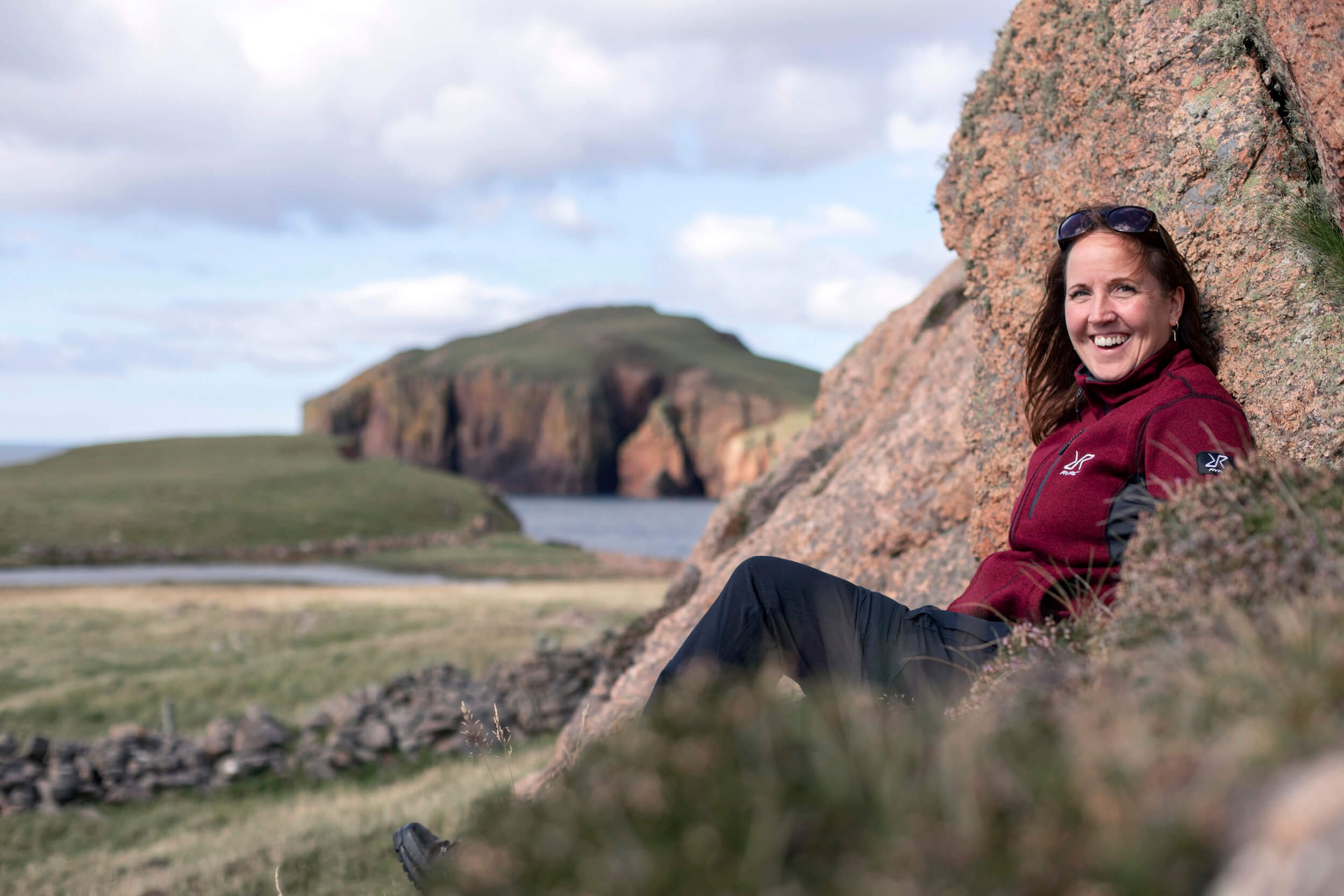
Hello, from Shetland
“When you see someone putting on his Big Boots, you can be pretty sure that an Adventure is going to happen.”
– A.A. Milne
These words spin through my head whenever I lace up my battered old hiking boots and set out on an adventure. Because that’s what life’s all about, is it not?
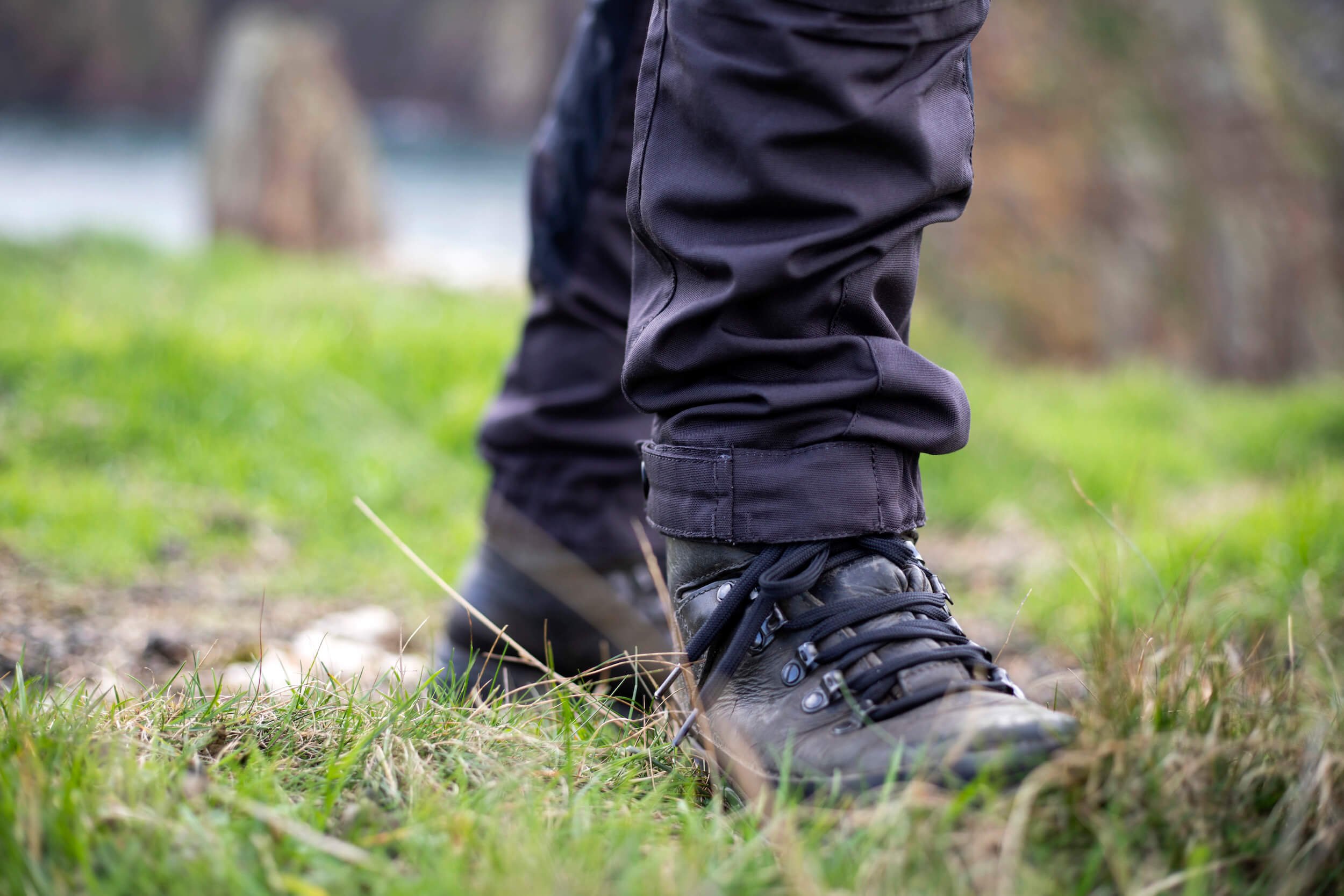
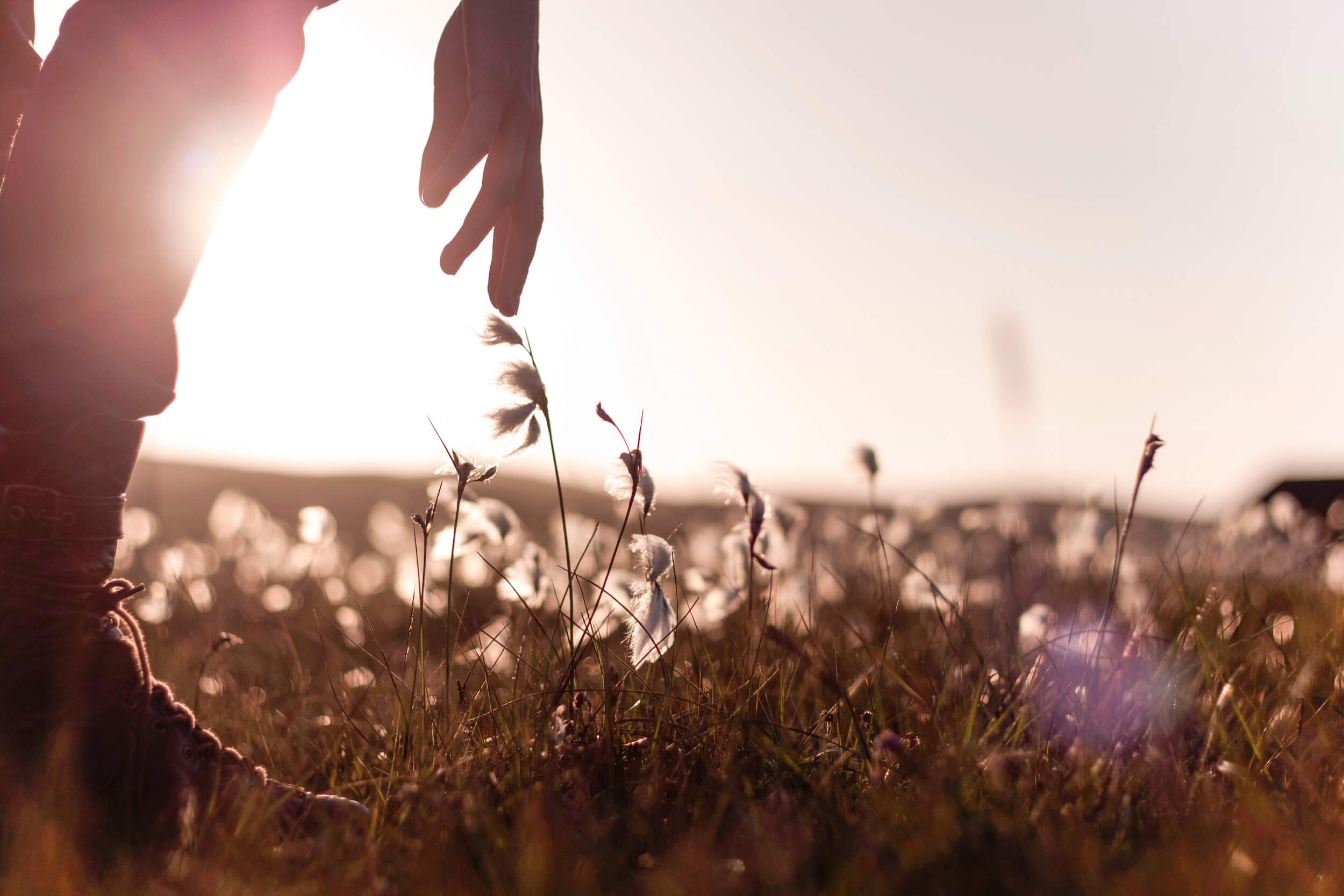
And that’s the basis of my little business – Shetland with Laurie – which I started in 2018 after growing tired of the drag of my day job and ground down by the corporate workplace.
Driven by a passion for the islands I call home, an underlying faith in myself and the wider universe, and under the whispering veil of warnings from well-meaning family members of ‘don’t do it, it won’t work’, I stepped off the merry-go-round of employment and spread my wings into the unknown.
With little more than a fledgling blog of musings – some pretty bad in those early days – and unwavering faith that it was the right thing to do, Shetland with Laurie was born. From the tiny seed of an idea and a passion for words, my blog grew …
Five years later, I’m proud of what I’ve achieved and how my business has evolved from a deeply buried blog on the final pages of Google’s search to an authoritative voice within the Scottish travel industry. I have written and contributed to big hitters in the industry, such as Lonely Planet, and featured on travel shows, blogs and tourism campaigns. My fledgling seedling has grown into a business and blog that I’m immensely proud of today.
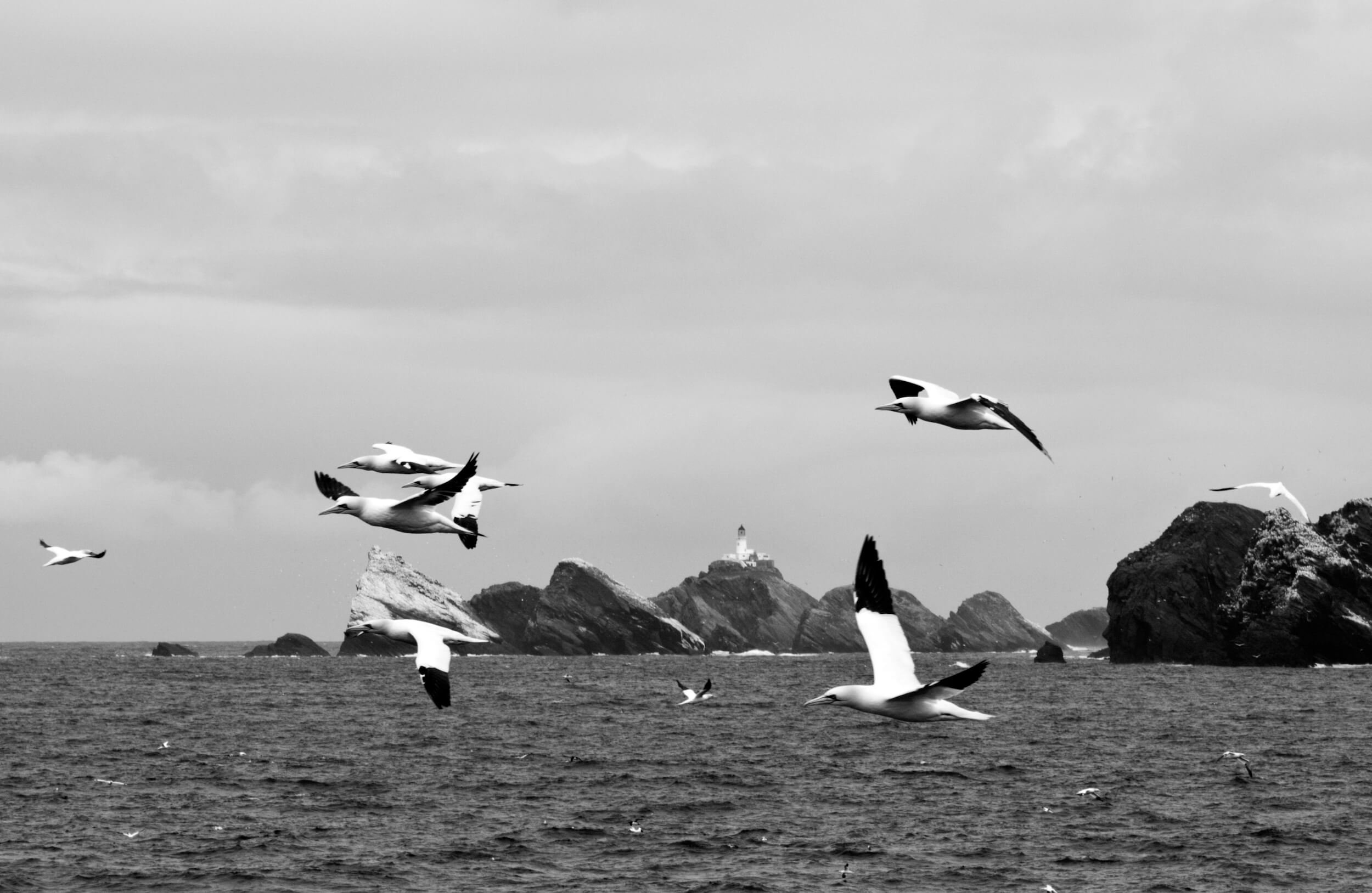
An islander by birth
Born to the islands, I can trace my ancestry back hundreds of years, and this sense of belonging is an important feature in my writing. I have lived in Shetland all my life – bar four years at Dundee University, where I achieved an MA in history and politics and, later, an MLitt in museum & gallery studies from St Andrews University.
Islands have always inspired me; they’re places where I feel at home. I can identify with the people and places and feel supported and nurtured by the familiar sights and smells of the sea surrounding them. It’s hard to describe islanders’ deep connections with the place they call home. It’s something deep and visceral – just out of reach – yet as tangible as the clear boundaries that define them, binding people to place and a clear spot on the map, setting the parameters to which we live our lives. This sense of connection drives my writing, feeds my soul and grounds me.
My love of islands, community and belonging has led me to other areas in my writing, adventuring to the far-flung St Kilda, an island on the edge of the world, the Outer and Inner Hebrides and around Orkney, discovering the people and places that make each island – each destination – unique.
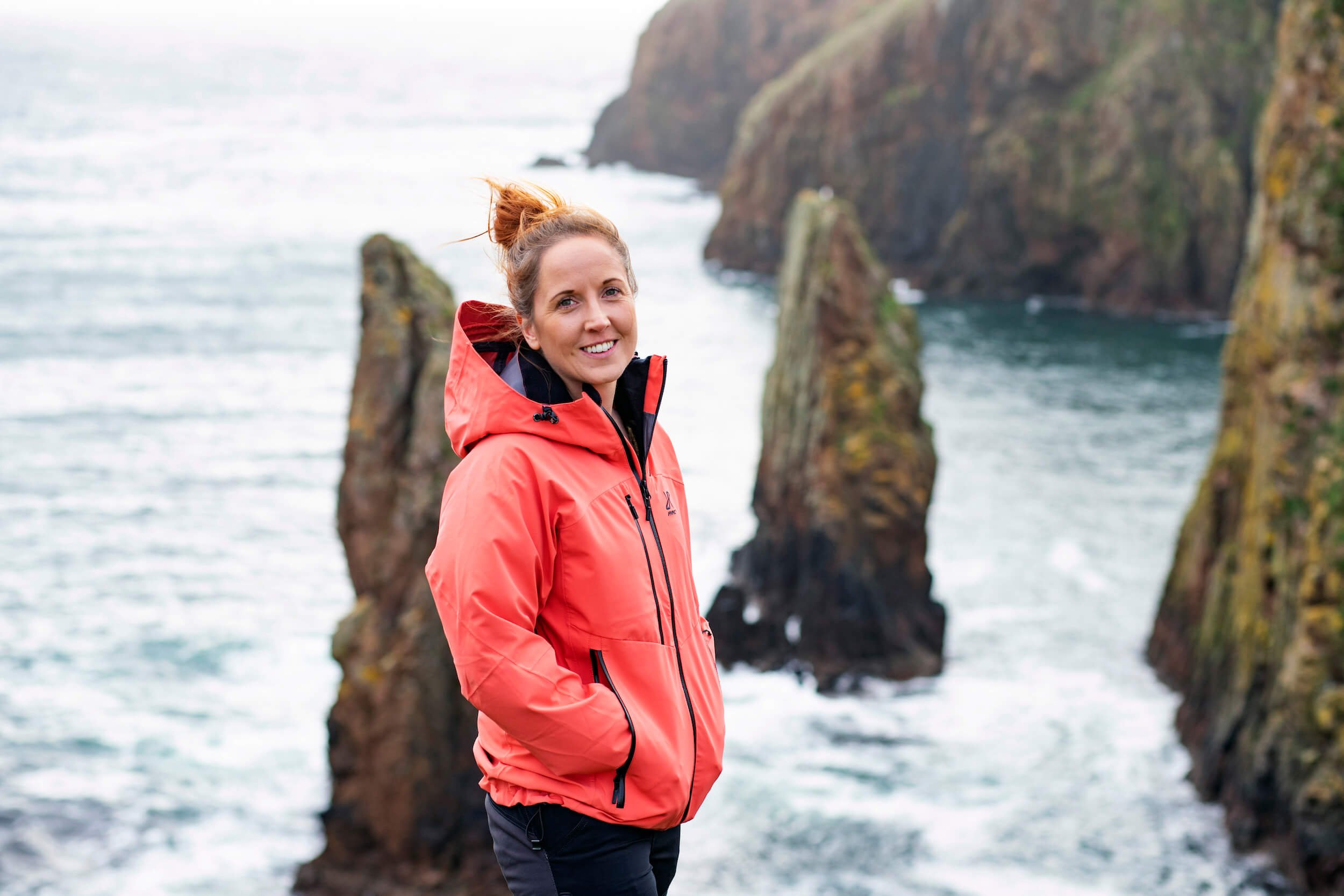
Island landscapes, the hills and the sea have always been a place of escape for me, where you’re never judged and where nature sweeps away all worries and cares from the world. These are the places I return to time and time again, allowing my words to flow like honey from a pot, conjuring up images and memories of past and present that are written on the landscape and locked into memory.
These are the places that light me up and that I want to share with others. Our islands may sit over the northern horizon, but they are within easy reach, and I love to help others open the door to unlock them and savour their rich, vibrant culture.
After graduation, I spent ten years working as an assistant curator at Shetland Museum & Archives, and I have continued to dabble in museums since leaving my job. Today, I’m the part-time curator of Scalloway Museum. Following a decade in museums, I edited Shetland Life magazine – a monthly, current, community lifestyle magazine. Shetland is rich in arts and culture, and the magazine celebrated the vibrant community spirit.
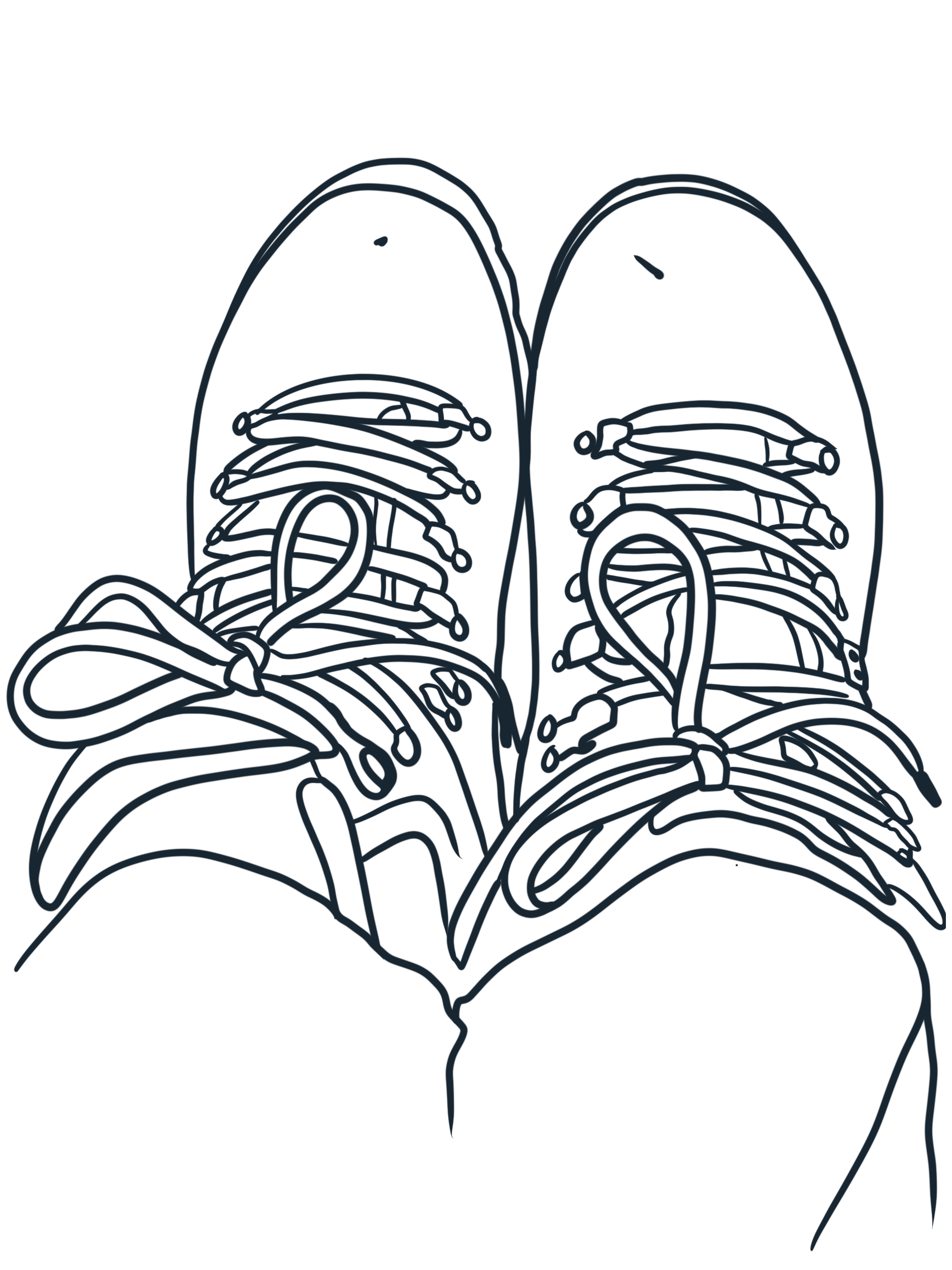
-
![]()
"We are so fortunate that Laurie spent the day with us touring the South Mainland. We saw so many things and had so much fun! She was very responsive to our requests, and made terrific suggestions about which sights to choose. Laurie is extremely well versed in the history and geology of the islands, and she's also a good listener who provided informed answers to our many questions. A definite highlight was our tour of Jarlshof, where Laurie's narration helped us to imagine the many lives intertwined there. Our day with Laurie was a high point of our time in Shetland! Thanks, Laurie."
-
![]()
"My friend and I booked a full day tour of the South Island with Laurie. She was extremely knowlegable about the history of the island and was also a lot of FUN!! This was a great way to see many sights and learn more about Shetland."
-
![]()
"I was so grateful to have Laurie as my solo tour guide for two days. The first day we toured the northern areas with the cliffs and then the southern areas on the next day. Having grown up in and studied the Islands she is THE expert and can tell you about the geology of the islands and the long history. She is also great fun and a good person to spend a couple of days with. I cannot be thankful enough for my time with Laurie on the beautiful Shetlands."
-
![]()
"Husband and I had Laurie take us on a walking tour on our last day in Shetland. She took us all over Lerwick and then some. She was very knowledgeable, sweet and helpful! And we love her! Would definitely come back for more..."
-
![]()
"Brilliant week night tour with Laurie who is so knowledgeable in what she does. Despite living in Shetland a long time I learnt so much about where we live. Fully enjoyable evening whilst also enjoying the simmer dim and fresh air. Would definitely recommend this activity whether you are a visitor or Shetland resident. Good value for money!"
-
![]()
"I decided to on a walking tour in Lerwick with Laurie after having lived here for almost 10 years. It was excellent. I thought the place but Laurie showed me so many details I had no idea about. Local guide who is passionate about her job. Plenty information, always time for questions and an unrushed experience all way through. Highly recommend Laurie."
-
![]()
"Laurie took us to the northern reaches of Mainland and was the perfect guide. She is knowledgeable, enthusiastic, friendly and funny. She’s a good driver, too! We had a totally delightful day in her company. I’m sure you will, too."
-
![]()
"It was an absolute pleasure touring around Shetland with Laurie -- she knows the islands inside and out and has such a vast understanding of the unique culture and history of Shetland. On top of that, she is such a lovely and pleasant person -- I can't imagine a better tour and would definitely recommend to anyone looking for the ultimate Shetland experience! Thanks Laurie!"
-
![]()
"So enjoyed this 2 hour interesting historical walking tour of Lerwick. Highly recommend! Thank you Laurie!"
-
![]()
"Superb tour. Laurie was very knowledgable and has an excellent manner. The tour was full of interesting information and history was really brought to life. She answered any questions clearly. A highly engaging way to learn about Lerwicks' past, would thoroughly recommend this tour for locals and visitors alike."
Visit my blog for local insights, tips and advice.
Think Shetland is just a remote outpost? Think again. This northern archipelago has been a vibrant crossroads of cultures and trade for centuries. Once a stronghold of the Viking world, Shetland remained under Norse rule until 1469 and still carries echoes of that legacy in its place names and dialect.
The islands have played host to everything from Hanseatic traders and Spanish Armada shipwrecks to Dutch spice merchants and WWII resistance missions like the daring “Shetland Bus.” Fishing has long been Shetland’s economic lifeblood, and even today, more fish are landed here than in the rest of the UK combined.
With its own dialect rooted in Old Norse (not Gaelic), a vast global diaspora, and archaeological finds dating back to Mesolithic times, Shetland’s history is anything but small or simple. Dive into its rich past and discover a place shaped by sea, survival, and cultural resilience.
For many people visiting Shetland, a trip to one or more of the outer isles is always on the itinerary, and in Shetland, visitors are spoilt for choice. With 16 inhabited islands, 15 of them available to visit – nine by inter-island ferry – it can be tricky to pick which one to explore.
This week, I will show you why you should visit one of the lesser-explored islands, and this blog focuses on Papa Stour, with Simmer Dim Charters.
A huge thank you to everyone who has booked a travel consultation with me—I’m now fully booked! I’ve absolutely loved helping you plan your Shetland adventures, and I can’t wait to see your trips come to life.
If you missed out this time, don’t worry! I’ll be reopening bookings in autumn, so keep an eye out for updates. In the meantime, happy trip planning! I look forward to chatting with more of you later in the year.
Since Christmas, I have conducted over 40 individual consultations with people from around the world. From America to Australia, and from London to Tokyo — it’s been a privilege meeting so many people and helping them plan their adventures.
Last week, a lovely testimonial arrived in my inbox, which I wanted to share with you:
10 Things to Know Before Visiting Shetland!
Planning a trip to Shetland? Here are some key things to keep in mind:
Book accommodation early – 8-12 months in advance is best!
16 inhabited islands – Choose wisely based on what you want to see.
Two seasons: summer & winter – Spring & autumn are fleeting!
One base is enough – No need to move around to see it all.
Cruise ship days are busy – Plan visits to Lerwick accordingly.
Getting here – You can only arrive by ferry or plane.
Winter closures – Many attractions shut from autumn to spring.
Puffins are seasonal – Visit between mid-April and mid-August.
Book tours & meals ahead – Guides & trips fill up fast in summer.
Stay longer! – Most visitors leave wishing they had more time.
I’ve always been drawn to northern places; perhaps it’s the familiarity or the sting of cold air on red cheeks, or possibly it’s the comparisons that can be drawn between my northerly place and another. Whatever the reason, the North Atlantic region and those areas that share a space on the latitude line with us fascinate me.
I’ve ventured to Iceland, Faroe and the far-flung St Kilda archipelago during my travels. All these places left a lasting impression on me in ways that more southern areas just don’t (sorry to those in the south, but the north just strikes a chord and stirs somewhere deep within my soul).
Last week, we stuck to our parallel line and headed 300 or so miles east of Shetland to the small town of Geilo, home to Norway’s best ski resort. Geilo sits almost halfway between Oslo and Bergen on the beautiful scenic train line which weaves through the mountains, connecting two of Norway’s most important economic and commercial centres. Home to just 2,500 or so residents, Geilo is flanked by mountains and sits at a latitude of 60.5334414 – similar to Lerwick, 60.152988.
The older I get, the more I crave experiences that ground me, that allow me to truly connect with the natural world. I find myself increasingly seeking spaces that offer respite from the constant hum of digital noise and the demands of modern life. Believe it or not, but I spend most of my days sitting at a computer – not the open spaces and horizons that you see on my Instagram stories!
So, when Haar Saua invited me to visit their sauna on the beautiful St Ninian’s Isle beach for an Aufguss session, I didn’t have to think twice. In Nordic cultures, there is a term that embodies this kind of immersive experience – In Sauna. It refers to the profound, almost spiritual feeling you get from the intense heat of a sauna; a place where time slows, and everything else fades away.
The Clift Hills are a series of low-lying hills (200-300 metres) that rise from Clift Sound. Royl Field (293m) is the largest of these hills and the second largest in Mainland Shetland (and the third largest in Shetland). During the Second World War, a de Havilland Mosquito Mk VII “DZ642” of the 627 Squadron, Royal Air Force, crashed on Royl Field on 22nd November 1944.
The Clift Hills dominate every area of the South Mainland. From Burra to the west, they rise steeply from the sea below, creating a ‘wall’ between east and west. In summer, low clouds and fog often threaten to spill over the hills from the east. When the South Mainland lies shrouded in a blanket of mist, the sun usually shines to the west, the hills providing a barrier against the encroaching sea fog.
Happy New Year, and thank you for coming back here to read this first blog of 2025. Who can believe it’s 2025? We’re a quarter of the way through this century. Crazy.
We had a fine festive period, very quiet, yet slowly productive in the nicest possible way. The betwixmas days brought a period of settled and still weather – unlike last year’s relentless 80mph winds that were driven in on violent easterly weather systems. The (relatively) settled weather in the final week of December saw us out and working on our drystone walls, which we’re building in the garden.
In 2020, just before the world as we knew it drew to a standstill, my husband and I went to New York. We spent five days exploring the city and ticking off all the ‘must sees’ from the list. I spent months planning the trip in a notebook, and while we were there, I kept a little diary of our time. We did all the main attractions: Chrysler Building, the Empire State Building, the Flatiron Building, Madison and Times Square, Central Park, the Statue of Liberty, Brooklyn Bridge, DUMBO, Top of the Rock and much more besides.
I loved the few days we spent there, but a part of me felt that I could have planned it better.
But why am I telling you all this? When planning the trip, I felt overwhelmed and frustrated that nobody would prepare it for me, sit me down, and tell me what I needed to do to make the most of this beautiful city. I felt sure someone would offer a service to create a perfect New York itinerary tailored to my needs, but there wasn’t.
Despite its relatively small size, Shetland has an incredible number of cultural heritage centres, supported by a willing army of volunteers who are passionate about recording the past, telling and sharing Shetland’s history, and celebrating the stories and folklore of the islands. Shetland has a strong storytelling tradition, and much of its cultural heritage has been preserved, meaning there’s a vast swathe of information to be explored. It’s perhaps therefore not surprising that for a community so passionate about its heritage, and one steeped in thousands of years of human history, that there are so many museums and heritage centres to explore.
Smaller community museums and heritage centres offer unique and detailed insights into individual communities – from the fascinating links to the wider world and entrepreneurial people who made their mark on the international stage, to the individual communities and the details of what shaped them.
From your journey here to the most accessible venues, accommodation and tours for your stay, we’ve worked with Ability Shetland to put together a guide to accessibility in the islands.
Shetlanders have always had an entrepreneurial spirit, and a make-do-and-mend attitude that has allowed them to thrive and the 18th and 19th centuries saw some of Shetland’s greatest contributions to modern medicine.
In the 18th century, smallpox would tear through communities here, killing up to one third of the population, and one man, John Williamson, made a tremendous contribution to the islands, saving thousands of lives in the process.
John Williamson, better known as Johnnie Notions, was a self-taught man. A seaman and weaver to trade, he had a keen interest in medicine. He lived in the North Mainland at a time when smallpox often ripped through communities, brought in by seamen.
After years of meticulous planning, research, and exploration, we are thrilled to announce the forthcoming release of our travel guide to Shetland. With stunning colour photographs and more than 250 pages brimming with useful information and insider tips, Shetland, Your Essential Travel Guide, is a labour of love, born from a shared dedication to showcasing the islands' natural beauty, intriguing history, and vibrant community life.
When you imagine Scotland, you think of quiet glens, river valleys, forests, gorges, lochs, and whisky that flows like water from tumbling burns. This is Moray Speyside; it’s a romantic image punctuated with visions of tartan-clad highlanders, heather, and ‘wild haggis’. It is liberally peppered with at least 50 malt whisky distilleries, making it one of the best-known regions, if less explored.
But we were here for more than just the uisge beatha, or ‘water of life’. Speyside is bursting with family-friendly activities and a drop or three of the strong stuff. This blog will show how you, too, can enjoy a family-friendly escape in Scotland’s whisky capital.
The Shetland Isles, a remote and captivating archipelago located in the North Sea, are a hidden gem waiting to be explored. If you're an avid caravanner looking for a unique adventure, taking your caravan to Shetland is a fantastic idea. With stunning landscapes, rich history, and warm hospitality, Shetland offers a one-of-a-kind experience that you'll cherish forever. In this blog post, we'll guide you through the essential tips for taking your caravan to Shetland, including places to pitch, and highlight some must-visit destinations on the islands.
Brydon Thomason is a Fetlar-born Shetland naturalist who has spent decades in Shetland’s landscapes, photographing and observing the incredible wildlife of our islands. Brydon is also the owner of Shetland Nature, who run wildlife holidays and guided tours throughout Shetland, and this latest book showcases his incredible archive of photographs, along with his insights into the seasons which, as they change, bring different wildlife experiences with them.
The book itself is a work of art, featuring 80 species illustrated through 179 images across 286 pages and opening with an incredible double-page spread of a raft of eider ducks, commonly seen throughout the winter months around Shetland waters. The captivating photographs are brought to life with Brydon’s words that take the reader on a journey through Shetland’s seasonal wildlife highlights.
Lying about 20 miles west of Shetland, Foula is one of the UK’s most remote islands, and arguably the most isolated of any island in the UK. With a population of about 35, many thousands of birds, and five square miles to explore, Foula has an ‘edge of the world’ feel and will leave a lasting impression on those who visit.
Sitting alone in the vast, often unforgiving expanse of the North Atlantic, Foula looms from the horizon and is visible on a clear day from most parts of Shetland’s west coast. Its looming silhouette represents the last outpost of the UK, a final frontier. Echoing noisily with the sound of hundreds of thousands of seabirds in summer, and hard to access in winter as its name suggests – the word Foula comes from the Old Norse Fugley, meaning ‘bird island.’
Orkney is a special island to Shetlanders; we share a ferry, an unreliable airline, Scandinavian ties and a friendly rivalry, which is amplified every time our football teams meet on the pitch.
Orkney, with a population of around 22,000, has about 70 islands, with 20 inhabited. Mainland Orkney can get busy during the high season, particularly on days when cruise liners visit, so it’s always worth considering an island trip. I’ve already written about our time in Westray, and in this blog, we explore Hoy.
With Hallowe’en upon us, I wanted to take a look at some of the spine-tingling and tragic tales from Lerwick. Last year, I explored Shetland’s haunted places, and this year, I wanted to focus on our capital town, Lerwick. Lerwick grew from the 1600s with Dutch fishermen coming here every summer to begin their summer herring fishery. The first mention of Lerwick came in 1625 when the lawmakers in Scalloway expressed concern about the lawlessness displayed in Lerwick, where smuggling, drinking, theft, assault and prostitution were cited as grounds to raze Lerwick to the ground.
When I first announced on social media that I was visiting Faroe, I was met with the usual ill-informed judgement that so often blights this proud nation, which today is an independent territory belonging to Denmark. This is something I’d like to clear up at the outset before I dive into a blog about our time in the islands. I have based this response around a particularly vitriolic email I received and, to prevent any further ill-informed comments, I’ve embedded that response into my website, here, and invite you to read this before forming judgement based on propaganda.
Faroe sits at 62° north, halfway between Shetland and Iceland. Like Shetland, it’s an island archipelago comprising 18 significant islands and many smaller islands, rocks and skerries. Where relatively low-lying hills form Shetland, the terrain of Faroe is mountainous, imposing and almost impossible to farm. It’s a rugged country where communities are strung out along the shoreline at the head of deep fjords or bays, many of which are connected today by tunnels, forging routes through mountains and undersea. Yet, despite its harsh landscape and climate, the islands are home to a thriving community of around 54,000 people – almost twice the population of Shetland living in a similar-sized island group.
As I write this, we are in the throes of the 14th Shetland Wool Week festival, which sees the arrival of knitters from all over the world in the islands to take part in the week-long celebration of Shetland’s textile heritage.
Wool Week is a hugely popular festival and marks the end of the busy summer season here in Shetland, and with this popularity comes high demand for accommodation, tickets and transport.
This blog is aimed at those planning to visit for Wool Week and how best to do this without too much stress!
I adore islands and love nothing more than exploring new ones I’ve never experienced before. I love the process, the planning and poring over ferry timetables, checking weather updates and discovering what makes each island unique and special.
In June, we visited Mull, an ideal springboard for exploring several other islands in the region, including Iona, Ulva and the Treshnish Isles.
I hate the term’ island hopping’; it conjures up images of mindlessly ticking islands from a list in a cavalier-style bid to ‘see them all’. In a way, this is what we were doing, but I hope that this blog will provide a glimpse into what each of these islands is like, what makes them unique and why you should make an effort to visit and explore some of Scotland’s smaller islands in a more immersive way.
I’m an island lass at heart. Islands run through my veins, and we were lucky enough to get the opportunity to spend some time exploring Mull recently. Islands provide an anchor to which I always return; they feel familiar and restorative – like home. The ever-present sea offers security and constancy in a fast-paced world. Islands allow me to slow down and breathe.
We spent our week with Mull Holiday Cottages, our trip coinciding with some of the best summer weather so far. Under the blue skies and turquoise waters of Mull, I was keen to explore these Inner Hebridean islands.
A mile offshore from Sandness, accessible several times a week by ferry from West Burrafirth, is Papa Stour, known locally as Papa. The name comes from the Old Norse language, meaning ‘the great island of the priests’. The island is geologically fascinating, formed from volcanic ash and lava, which is a real gift to hikers seeking the drama, allure and breathtaking vistas offered by the incredible coastline.
This fertile and lush island had a population of 382 in 1841, which has declined steadily over the past 40 years. Today, the 15 or so permanent residents no longer have a school or shop, and there are few facilities on the island for visitors beyond the Ferry Waiting Room and church, which is undergoing renovation. Despite this, Papa is an island that calls to be explored, offering endless hours of enjoyment along its rugged coastline. The main settlement centres around the ferry harbour on the fertile east coast of the island at Housa Voe.
Out Skerries, known locally as Da Skerries or just Skerries, are a small low-lying trio of islands – Housay, Bruray and Grunay – that lies 13 miles off Shetland’s east coast, and four miles northeast of Whalsay. The coastline is a patchwork of small rocks and skerries that rise uncertainly from the sea on Shetland’s eastern horizon.
The island is home to around 30 people who are largely dependent on the fishing industry. Bruray and Housay are connected via a road bridge, and Grunay, which offers protection for the harbour, is now uninhabited, although the remains of the lighthouse buildings associated with the dominating Bound Skerry Lighthouse can still be seen across the harbour.
For this island adventure, we travelled to Mull. Mull is part of the Inner Hebrides and sits off the west coast of Scotland, with Islay, Jura and Colonsay to the south, Kerrera and Lismore to the east, Coll and Tiree to the west, and the uninhabited Treshnish Isles and Staffa. Mull is an island known for its wildlife, scenery and fascinating geology; it shares much of its allure with Shetland, yet is distinct and different in many ways, as we were to discover.
For as long as I can remember we have marked the passing of the longest day; whether that be a midnight walk to the top of a hill to watch the sun set and rise again, eating freshly caught mackerel straight from the sea, or a camping trip in a quiet valley listening to the call of the birds and watching as the mist rolls in over the hills like frosting.
Midsummer is the time around the summer solstice when the days melt into the night and the evenings remain still and light as the earth is bathed in a milky light which never really turns to darkness.
A few weeks ago, we were invited to come and stay at Shetland Glamping’s beautiful new pods at Rerwick. Enjoying incredible sea views across rolling countryside and out to sea, Shetland Glamping is the hottest new accommodation offering in Shetland’s South Mainland. After opening last summer, the guest book in our pod Shalder was already bursting with rave reviews for their luxurious ‘Mega Bunker’ Glamping Pods.























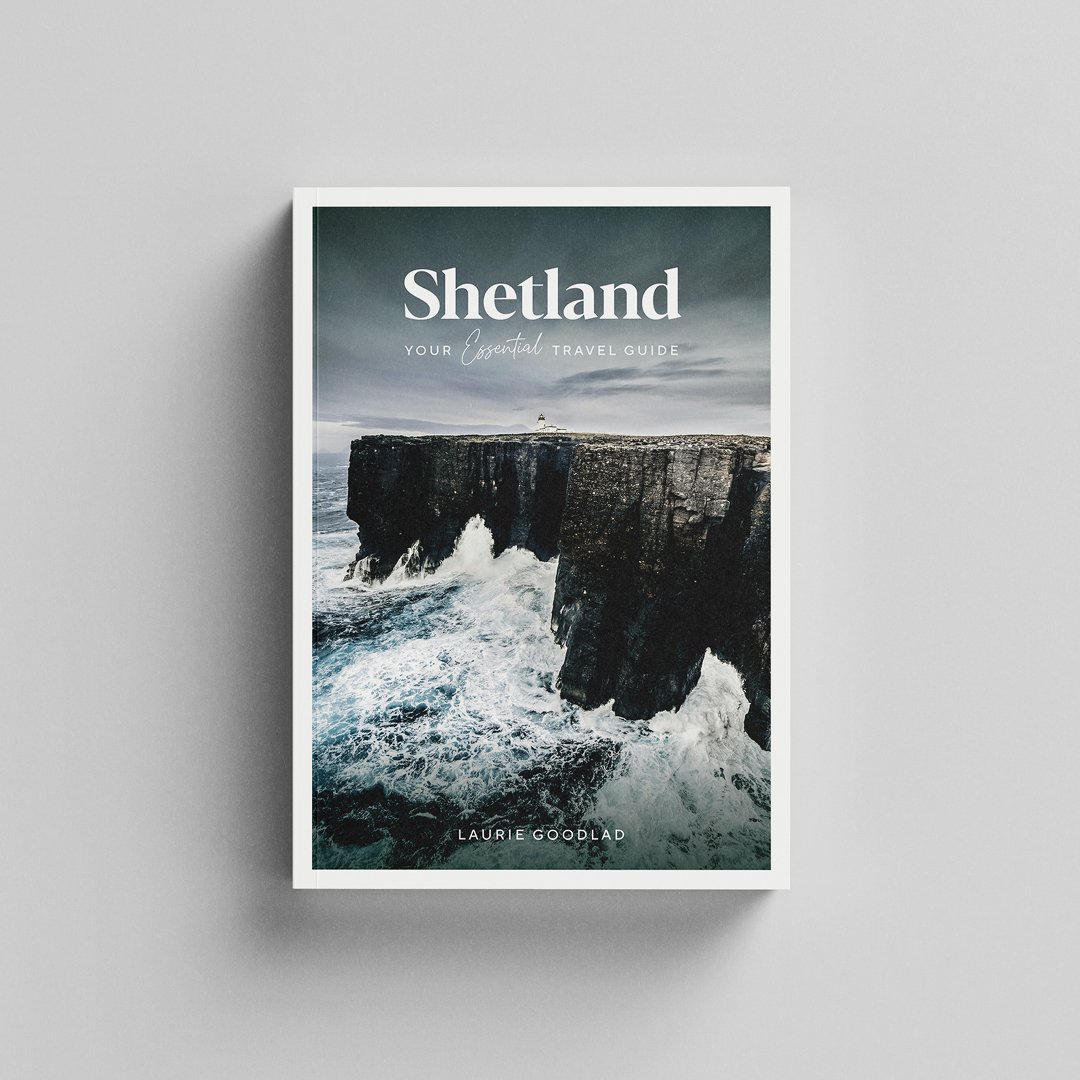


















Nestled at the end of a winding country road just outside Vidlin, Kirkabister is a beautifully restored traditional cottage overlooking the sheltered waters of Vidlin Voe.
New to Shetland’s self-catering market, Kirkabister has been thoughtfully brought to life by owner Lynsey, whose attention to detail is seen throughout.
Sleeping up to eight guests, Kirkabister is ideal for families or groups looking to make the most of their Shetland holiday. Warm, welcoming, and rich in story, it’s more than a place to stay – it’s a home to return to. Read on for a full travel itinerary.